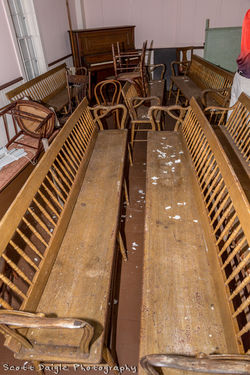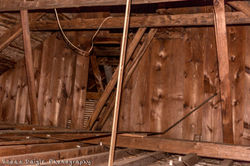
THE QUAKER MEETING HOUSE
A RESTORATION PROJECT
ONCE IT IS GONE... IT IS GONE.
The Friends Meeting House on Prospect Street dates back to 1701. It is the oldest structure in Somerset. The Massachusetts Historical Commission has designated it the oldest meetinghouse in the Commonwealth, and it is one of the oldest houses of worship in the United States. In 2013 it was listed on the National Register of Historic Places.
The structure is a valuable part of our community's heritage. But it is more than that. The Friends Meeting House is distinguished from other historic sites in town because it is the physical embodiment of the early history of Somerset, Massachusetts in a way that very few buildings can be.
 |  |  |  |  |  |  |
|---|---|---|---|---|---|---|
 |  |  |  |  |  |  |
 |  |  |  |  |  |  |
 |  |  |  |  |  |  |
HELP SAVE THE QUAKER MEETING HOUSE

Purpose of the Friends of Somerset Historic Preservation
The Friends Meeting House on Prospect Street dates back to 1701. It is the oldest structure in Somerset. The Massachusetts Historical Commission has designated it the oldest meetinghouse in the Commonwealth, and it is one of the oldest houses of worship in the United States. In 2013 it was listed on the National Register of Historic Places.
Each of these criteria support the idea that the structure is a valuable part of our community's heritage. But it is more than that. The Friends Meeting House is distinguished from other historic sites in town because it is the physical embodiment of the early history of Somerset, Massachusetts in a way that very few buildings can be.
Formation of Friends of Somerset Historic Preservation
In 2016, a new organization was formed in response to the structural crisis at the Friends Meeting House. Its mission statement is as follows:
Friends of Somerset Historic Preservation (FOSHP) is a 501c3 public non-profit organization of Somerset residents whose interest is the preservation of our historic structures and landmarks. Twenty-first century townspeople are surrounded every day by visible clues to Somerset's history and culture. Our goal is to identify, commemorate, and preserve our local treasures, not only for today's residents but for future generations of townspeople as well.
Nonprofit Status
FOSHP aims to accomplish its goals through fundraising and private donation. FOSHP is a 501c3 public non-profit. Our bylaws designate us as an umbrella organization to support and manage fundraising efforts for historic preservation in the Town of Somerset. The Town Administrator has granted our organization permission to pursue grant funding for the Friends Meeting House from the Hathaway Memorial Charitable Trust. The building is owned by the Town of Somerset.
In 2008, the last surviving members of Friends Meeting House transferred the deed of the property to the Town of Somerset, with the expectation that the meetinghouse would be preserved and maintained for appropriate community use. In 2010, the Somerset Historical Commission funded a feasibility study prepared by Maximillian Ferro, historical architect, and focusing on the condition of the Meeting House. Mr. Ferro's study concluded with a warning to undertake immediate measures for the preservation of this historic building. His report further encouraged interested citizens to "pursue grants, donations, and a town appropriation to implement a program of engineering investigation" and crucial attention to preservation.
The next professional assessment did not take place until five years later after part of a tree broke through the Meeting House roof during a violent storm. In 2015, the Town of Somerset commissioned a structural investigation prepared by Nelson Bernardo of Bernardo Engineering and Architectural Design. The investigation found that the roof structure itself appeared to be in good condition. However, Mr. Bernardo had found the condition of the shingles to be poor, and he had discovered some sheathing planks that had cracked and failed in localized areas. The report concluded that the roofing and the damaged sheathing planks "must" be replaced, as water penetration was obvious.
Geographic Area Served
The Quaker Meeting House, once restored and preserved, will serve the entire Town Somerset and its surrounding communities.
Why Save the Quaker Meetinghouse?
The Town that is Somerset today can trace its origins back to the final days of King Philip's War. By 1677, the native people were utterly destroyed and Plymouth Colony was economically devastated. To raise revenue, a thickly forested peninsula and its surrounding area was declared a prize of war by the Plymouth colonial legislature and put up for sale. The land was ancient tribal territory that the defeated Pocassets had called Shawomet. Its boundaries were nearly identical to those of 21st century Somerset.
A young man named William Slade was living in Newport, Rhode Island when the land in Shawomet became available. William traveled to Plymouth in hopes of gaining permission to buy property along the Taunton River. He was probably very surprised when the authorities agreed to sell him some. Slade was a member of the Society of Friends, a savagely persecuted denomination of Protestant Christians who were excluded from every New England colony with the exception of Rhode Island. Other members of the Friends, also known as Quakers, followed Slade's example and they, too, were accepted as landowners in what was now called the Shawomet "precinct" of the already established frontier town of Swansea. Several families from Portsmouth and Newport, Rhode Island moved into south Somerset in 1680. Some of their names are preserved today by street names that indicate the location of their farms. Slade, Wilbur, Brayton, Chase, and Buffinton are some examples.
By October 9, 1701, the Quakers had increased their numbers enough to necessitate the construction of a "little Meeting House... at a place called Wickapimset." This structure, when completed a few months later on the Prospect Street site where it still stands 316 years later, was the first house of worship in Somerset. Records of the Friends Meeting indicate that the original "little meeting house" was enlarged in 1746, in 1872, and again in 1889. The official name of the building is the Swansea Friends Meeting because Somerset was a part of Swansea when it was first built.
The Quakers who gathered at the "little meeting house" can rightly be called the founders of Somerset. They were, by 1700, the predominant population of the settlement. Thus, they would have decided such matters as where the first roads, still in use today, would be laid out. They would have had a considerable say in selecting our first law enforcement official and our first schoolteacher. The Quaker belief in gender equality exerted a strong influence on the community's educational philosophy, making the embryonic school system one of the few in all the colonies where girls attended lessons along with the boys.
The Quaker founders of Somerset also had a remarkable influence on the struggle for religious liberty in the Commonwealth. Old Plymouth Colony, of which today's Somerset was a part, had never recovered from the damages inflicted by King Philip's War. In 1692, it was absorbed into Puritan Massachusetts. Quakers were banned from settling in the Bay Colony, and several had been hanged on Boston Common for their attempts to do so. But, in 1692, Massachusetts guaranteed by law that Quakers living in the former Plymouth Colony were free to worship as they pleased. However, for as long as they lived under Massachusetts rule, Quakers would be required to contribute toward the support of a Puritan minister.
This was not acceptable to the Prospect Street Quakers. At a town meeting, they adamantly refused to expend 100 pounds for support of an unwanted minister. Instead, the Quakers taxed themselves five times that amount to defend themselves in court. Their defiance gained a following and so much pressure was brought to bear that in 1728, the Massachusetts legislature passed a bill exempting "Quakers... from being taxed for the support of ministries." The Quakers' objection to their government promoting one religion over another is a concept that ultimately found expression in the First Amendment of the Constitution.
A nationally historic figure was closely associated with the Friends Meeting House during the 18th century. In 1760, members of the meeting chose a young woman to be their minister and authorized her to preach on social concerns and how best Quakers could address them. The woman's name was Patience Brayton and her concern was African slavery. Today, she is recognized as one of the nation's earliest voices to condemn slavery as a moral evil and to insist that it had to end. Patience Brayton was an abolitionist who was one hundred years ahead of her time.
Slavery was an accepted and pervasive part of the culture throughout small towns in Southeastern Massachusetts. There had been slaves in Somerset since 1680. No one questioned it and probably no one gave it much thought. Patience was a Rhode Island Quaker who arrived at Friends Meeting House as the bride of a well-to-do farmer. Her husband maintained his properties through the labor of the slaves he owned. Patience Brayton had an unshakable belief that slavery was incompatible with the teachings of her faith. Shortly after her marriage, the Brayton slaves were given their liberty. As time went on, slavery, at least among the Quakers, ceased to exist in Somerset.
In 1771, Patience Brayton continued her crusade against slavery by undertaking a grueling, yearlong journey that brought her to each of the English Colonies scattered along the East Coast. Her reputation as a charismatic speaker drew increasing numbers of both Quakers and non Quakers who came to hear her in meetinghouses, barns, and school rooms. After her death, her journals providing detailed accounts of her travels were published as a biography by the members of Friends Meeting House in 1802.
At the time of her death, in 1794, four American states had declared slavery illegal, and Quakers throughout the world had abolished slavery among themselves.
Patience Brayton was buried in the old cemetery behind Friends Meeting House. Her grave is unmarked because 18th century Quakers believed that a person's deeds were a more fitting commemoration of a life than was a headstone. In 1976, the Somerset Bicentennial Committee observed our country's 200th anniversary by placing a monument in the cemetery in remembrance of Patience Brayton.
The Friends of Somerset Historic Preservation are working to preserve the structure and the history of the people who built it. They were the founders of Somerset, and they left us a past that gives us pride of place. We honor the past by preserving it for the future.
— Mary Ann McDonald, Executive Chair, Friends of Somerset Historic Preservation


